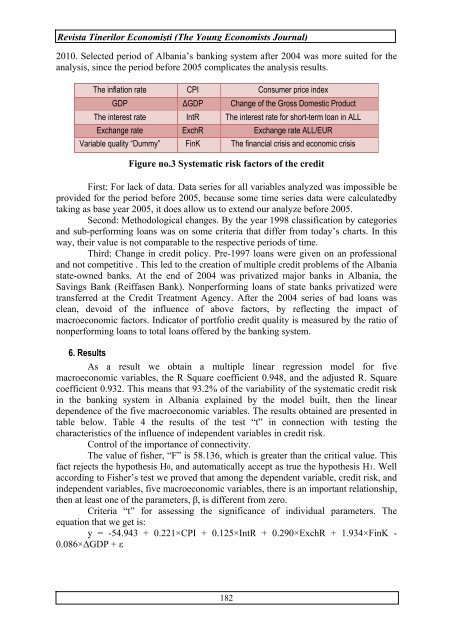Revista Tinerilor Economiºti (The Young Economists Journal)
Revista Tinerilor Economiºti (The Young Economists Journal)
Revista Tinerilor Economiºti (The Young Economists Journal)
Create successful ePaper yourself
Turn your PDF publications into a flip-book with our unique Google optimized e-Paper software.
<strong>Revista</strong> <strong>Tinerilor</strong> Economişti (<strong>The</strong> <strong>Young</strong> <strong>Economists</strong> <strong>Journal</strong>)<br />
2010. Selected period of Albania’s banking system after 2004 was more suited for the<br />
analysis, since the period before 2005 complicates the analysis results.<br />
<strong>The</strong> inflation rate CPI Consumer price index<br />
GDP ΔGDP Change of the Gross Domestic Product<br />
<strong>The</strong> interest rate IntR <strong>The</strong> interest rate for short-term loan in ALL<br />
Exchange rate ExchR Exchange rate ALL/EUR<br />
Variable quality “Dummy” FinK <strong>The</strong> financial crisis and economic crisis<br />
Figure no.3 Systematic risk factors of the credit<br />
First: For lack of data. Data series for all variables analyzed was impossible be<br />
provided for the period before 2005, because some time series data were calculatedby<br />
taking as base year 2005, it does allow us to extend our analyze before 2005.<br />
Second: Methodological changes. By the year 1998 classification by categories<br />
and sub-performing loans was on some criteria that differ from today’s charts. In this<br />
way, their value is not comparable to the respective periods of time.<br />
Third: Change in credit policy. Pre-1997 loans were given on an professional<br />
and not competitive . This led to the creation of multiple credit problems of the Albania<br />
state-owned banks. At the end of 2004 was privatized major banks in Albania, the<br />
Savings Bank (Reiffasen Bank). Nonperforming loans of state banks privatized were<br />
transferred at the Credit Treatment Agency. After the 2004 series of bad loans was<br />
clean, devoid of the influence of above factors, by reflecting the impact of<br />
macroeconomic factors. Indicator of portfolio credit quality is measured by the ratio of<br />
nonperforming loans to total loans offered by the banking system.<br />
6. Results<br />
As a result we obtain a multiple linear regression model for five<br />
macroeconomic variables, the R Square coefficient 0.948, and the adjusted R. Square<br />
coefficient 0.932. This means that 93.2% of the variability of the systematic credit risk<br />
in the banking system in Albania explained by the model built, then the linear<br />
dependence of the five macroeconomic variables. <strong>The</strong> results obtained are presented in<br />
table below. Table 4 the results of the test “t” in connection with testing the<br />
characteristics of the influence of independent variables in credit risk.<br />
Control of the importance of connectivity.<br />
<strong>The</strong> value of fisher, “F” is 58.136, which is greater than the critical value. This<br />
fact rejects the hypothesis H0, and automatically accept as true the hypothesis H1. Well<br />
according to Fisher’s test we proved that among the dependent variable, credit risk, and<br />
independent variables, five macroeconomic variables, there is an important relationship,<br />
then at least one of the parameters, β, is different from zero.<br />
Criteria “t” for assessing the significance of individual parameters. <strong>The</strong><br />
equation that we get is:<br />
y = -54.943 + 0.221×CPI + 0.125×IntR + 0.290×ExchR + 1.934×FinK -<br />
0.086×ΔGDP + ε<br />
182















